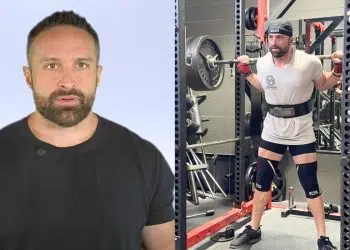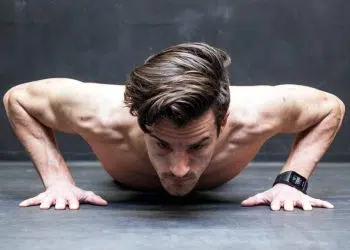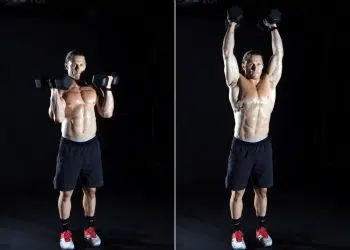The dumbbell iron cross is undoubtedly a unique exercise that isn’t talked about much (at least not from what we’ve seen). But it’s certainly useful and a great way to train several muscles at once.
Primarily, it hits the deltoid heads or shoulders but it does involve a squat and therefore, is a good overall movement. It’s not a mass builder but can certainly help to improve your muscle tone and also makes for a good cardio type activity.
In this guide, we provide more details about this exercise.
In This Exercise:
- Target Muscle Group: Shoulders
- Type: Hypertrophy, strength
- Mechanics: Compound
- Equipment: Dumbbells
- Difficulty: Beginner
How To Do The Dumbbell Iron Cross
There are apparently a few different variations of the dumbbell iron cross. But we’ve provided exercise instructions for the one that we’ve determined is most commonly demonstrated or used.
- Stand with feet about shoulder-width apart and hold a dumbbell in each hand, palms facing in.
- Raise both arms up in front of you and squat down halfway as shown in the video below. Try to remain as upright as possible.
- Drive through your midfoot to stand back up while simultaneously opening your arms to form a cross.
- Repeat for the desired reps.
Here’s a video example…
Dumbbell Iron Cross Tips
- Make sure to use light dumbbells and warm up your shoulders before using more challenging weights.
- Avoid using heavy dumbbells for this exercise. It’s not an appropriate exercise for using maximum poundages.
- Keep a proper posture throughout the entire exercise. Do not lean too far forward.
- You could squat to a desired depth although it’s not necessary.
Muscles Worked
The dumbbell iron cross can be considered a full body workout as it uses nearly every muscle in the body. Let’s take a look at the muscles involved.
Deltoid Lateral
Iron cross will have your deltoid muscles screaming. Shaped by three heads – anterior, lateral, and posterior, the shoulder muscles are part of the glenohumeral joint that connects the arm to the trunk of the body. Therefore, the deltoids help to move the arms in various directions.
Level Up Your Fitness: Join our 💪 strong community in Fitness Volt Newsletter. Get daily inspiration, expert-backed workouts, nutrition tips, the latest in strength sports, and the support you need to reach your goals. Subscribe for free!
The deltoid lateral or outer head lifts the arm up laterally away from the torso from an angle between 15 and 100 degrees. An example is forming a “T” with your arms.
Deltoid Posterior
The rear deltoids on the back of the shoulder are also working hard back there to keep the arms and shoulder blades retracted.
The quadriceps or quads is the large slab of muscle at the front of the upper leg. It consists of four heads and is an extremely powerful muscle involved in all lower body (many upper body exercises too) exercises and activities.
Its functions include hip flexion, knee extension, posture maintenance, and it’s involved during the gait (walking) cycle and it helps to maintain patellar stability.
The dumbbell iron cross involves the quadriceps during the squat portion of the exercise.
Quadriceps
The quadriceps or quads is the large slab of muscle at the front of the upper leg. It consists of four heads and is an extremely powerful muscle involved in all lower body (many upper body exercises too) exercises and activities.
Its functions include hip flexion, knee extension, posture maintenance, and it’s involved during the gait (walking) cycle and it helps to maintain patellar stability.
The dumbbell iron cross involves the quadriceps during the squat portion of the exercise.
3 Dumbbell Iron Cross Variations
There are other similar movements of the dumbbell iron cross that are also beneficial and we’ve included them below.
1. Dumbbell Iron Cross Walk
If you want a more functional option, this is a great variation.
To do it, you’ll grab a pair of light/medium dumbbells, raise your arms out to the sides and hold the dumbbells using a neutral grip. Walk for a distance and when you stop walking, lower the dumbbells by your sides turn in the opposite direction and walk back to your original spot.
2. No Squat Variation
Another variation is to omit the squat portion. You’d simply start from the standing cross position, bring your arms together in front of you, move them back, and then lower them down before repeating this movement.
3. Kettlebell Iron Cross
You could also use kettlebells to do this exercise and it’s actually an interesting variation because it no doubt challenges your stability more than if you were using dumbbells.
We’ve provided a video example below so that you can replicate the movement.
How To Incorporate The Dumbbell Iron Cross Into Your Training Routine
Again, the dumbbell iron cross isn’t going to be some mass-building movement, simply because you won’t be able to use near maximum loads.
But what you can do use it as a functional exercise that’ll still help to strengthen your muscles.
It makes for an excellent warm-up activity before you do other exercises; a good option when you’re short on time or have limited equipment.
Or maybe you want to incorporate it into your workouts as a finisher or include it during a circuit training session.
There’s no perfect answer to how it should be included in your training. Just make sure to do it and with proper form.
Sets/reps
While it’s not really a mass-builder and you can’t use a lot of weight, you still want to get some benefit from it. Therefore, we recommend 2-4 sets of anywhere from 8-25 reps.
This will allow you to train safely and effectively. Make sure that you can comfortably hold the dumbbells but you shouldn’t have to fight with everything to keep them up.
Wrapping Up
The dumbbell iron cross makes for a great addition to an exercise regime for many reasons. You don’t have to practice pilates or yoga to do it and see the benefits either.
So, give it a try… you could end up really enjoying its utility.
Interested in measuring your progress? Check out our strength standards for Squat.











